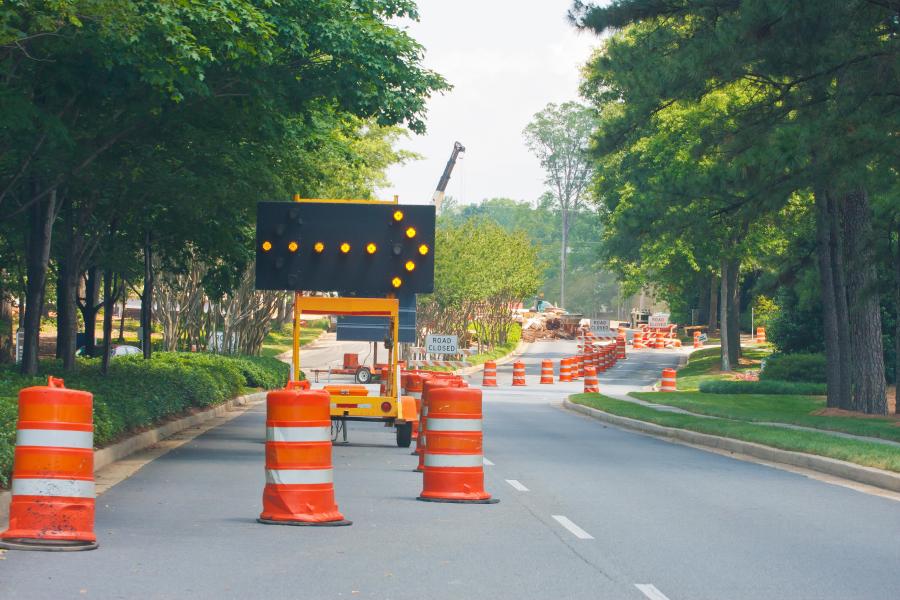The seven projects chosen in the latest round of the DOT’s Every Day Counts program focused on three areas: safety, sustainability and then equity and inclusion.
The DOT has expanded its Every Day Counts (EDC) program from innovative infrastructure projects to tackling climate and safety. Seven projects were added to the list of 52 the department has supported in the decade-old federal initiative program.
The goal of the Obama-era DOT program Every Day Counts was to nudge states in using innovative strategies to update their transportation systems.
Every other year, the program comes out with a new list of projects it will support. The agency has expanded the program to include multiple transportation modes.
In announcing the seven new projects in early December, the DOT said the program will focus more intently on traffic safety and emissions reduction. The expansion in types of projects reflects the national push for transportation infrastructure improvements as a result of the bi-partisan IIJA, according to the DOT.
The FHWA had in the past worked with state transportation agencies to zero-in on appropriate innovations. Collaborating with agencies such as the FTA and the FRA, the DOT was able to grow the program beyond just infrastructure.
"All the innovations in the past were chosen just with state transportation highway departments in mind," said Stephanie Pollack, the acting administrator of the FHWA. "This set was chosen with a broader set of modes."
Improvements to nighttime safety, a push for rural and tribal workforce development are among the latest innovations. So is an initiative to integrate greenhouse gas assessments into transportation planning.
Though its name is Every Day Counts, the program isn't just about speeding up transportation innovation, according to Bloomberg News.
"It's not just faster," said Pollack in announcing this latest round of innovations. "The seven innovations were chosen to not just focus on faster project delivery, but the three big buckets — safety, sustainability and then equity and inclusion."
The FHWA sits down with local governments and their transportation departments and stakeholders to choose each new set of projects. Previous rounds of the Every Day Counts program included technology to accelerate bridge construction and digital ticketing, according to Bloomberg.
The program's shift to embrace other transportation modes comes as concerns about U.S. car dependence continue to grow.
EDC's new project devoted to nighttime safety, for example, is designed to boost visibility for all users, including cyclists, pedestrians and transit riders.
"We're really excited about making this tool that's been proven in the highway context available in all the different modes of transportation," Pollack said.
This year's innovations being promoted by the FHWA and the FTA will improve project delivery across highway, rail and transit agencies at the state and local level.
"Americans get the best value out of innovations in transportation when they are broadly shared among communities so that good ideas spread across the country," said U.S. Transportation Secretary Pete Buttigieg. "With today's announcement, these innovations will be more rapidly deployed to save lives, protect taxpayer dollars, reduce carbon emissions and ensure more families, workers and businesses benefit."
Showcasing Innovation
This latest round of the DOT's Every Day Counts innovative projects:
- Nighttime Visibility for Safety
Since the nighttime crash fatality rate is three times that of the daytime, enhancing visibility along corridors, intersections and pedestrian crossings helps reduce fatalities. This initiative promotes traffic control devices and properly designed lighting to improve safety for all users, including pedestrians, cyclists and people who use public transportation and passenger rail services.
- Next-Generation Traffic Incident Management
More than six million crashes a year in the United States put responders and other vulnerable road users at risk. Next-Generation Traffic Incident Management programs promote emerging technologies such as emergency vehicle lighting and queue warning solutions. These and other tools can advance safety and operations to help keep crash responders safe and mitigate traffic impacts after a crash, according to the DOT.
- Integrating Greenhouse Gas Assessment and Reduction Targets in Transportation Planning
This initiative provides resources to help agencies, regardless of transportation mode, quantify greenhouse gases and set goals to decrease motor vehicle, construction and life-cycle emissions through planning and project development.
- Enhancing Performance with Internally Cured Concrete (EPIC)
Cracking in concrete is a limiting factor in achieving long-term concrete performance. Internal curing mitigates shrinkage cracking and has the potential to substantially extend the service life of concrete bridge decks, benefitting travel by motor vehicle and public transit, as well as enhancing the performance of pavements and repairs.
- Environmental Product Declarations (EPDs) for Sustainable Project Delivery
Construction materials such as concrete and asphalt have environmental impacts during their life cycle, whether the transportation facility supports passenger vehicles, transit vehicles, or railroad cars. EPDs, which document those impacts, help states support procurement decisions and quantify embodied carbon reductions using life cycle assessments for sustainable pavements.
- Rethinking Disadvantaged Business Enterprise (DBE) in Design-Build
Many design-build contracts do not adequately provide opportunities for disadvantaged businesses. New practices are available to support the effective integration of program requirements to help small, disadvantaged businesses compete for design-build contracts for highway and transit projects.
- Strategic Workforce Development
The demand for highway workers is growing under the new investment of the IIJA, and emerging technologies require new skills. This innovation is being implemented by 32 states, with six of those states having institutionalized Strategic Workforce Development as the way to promote career opportunities in transportation. A continued focus on taking this nationwide will help stakeholders across the country improve their ability to identify, train, and place highway construction workers.
Innovative approaches will be informed by the DOT's Memorandum of Understanding with the DOL to foster a diverse and skilled workforce to support infrastructure projects.
The focus will expand to rural and tribal communities to increase career opportunities.
"Many of the innovations announced as part of this forward-thinking program will help make the nation's transit systems safer, greener and more equitable," said Nuria Fernandez, the FTA administrator. "We look forward to promoting the findings from these initiatives, from reducing greenhouse gas emissions to leveling the playing field for small businesses to compete for design-build contracts, throughout the transit industry."
History of Success
Every two years since 2011 FHWA has worked with state transportation departments, local governments, tribes, private industry and other stakeholders to identify a new set of innovations to champion that merit accelerated deployment.
The first six rounds of EDC have yielded several innovative project delivery technologies, including prefabricated bridge systems, design-build contracting, project bundling, e-construction (paperless contracting) and safety initiatives.
The program's success is based largely on states selecting innovations they want to pursue.
The model identifies and rapidly deploys underutilized innovations to shorten the project delivery process, enhance roadway safety, reduce traffic congestion and integrate automation.
Proven innovations promoted through EDC facilitate efficiency at the state and local levels, saving time, money and resources, said the National Operations Center for Excellence (NOCOE).
After selecting EDC innovations, transportation leaders from across the country gather at regional summits to discuss and identify opportunities. It is there that innovations that best fit the needs of their respective state transportation programs are implemented.
Following the summits, states finalize their selection of innovations, establish performance goals and begin implementation.
NOCOE said the EDC program has made a significant positive impact in accelerating the deployment of innovations and in building a culture of innovation within the transportation community.
"Since the inception of EDC, each state has used 19 or more of the 52 innovations promoted through Every Day Counts, and some states have adopted more than 40," said the organization.
Many of these innovations have become mainstream practices across the country.
Accelerated Innovation Demonstration and State Transportation Innovation Council Incentive programs administered by FHWA provide additional funding and resources to help accelerate the adoption and standardization of innovative technologies.
Previous innovations include Accelerated Bridge Construction, Road Diets, and Safe Transportation for Every Pedestrian (STEP).
The bridge construction program involved a suite of technologies that allow for accelerated construction of bridges, significantly reducing traffic delays and road closures and often reducing project costs.
Since October 2010, transportation agencies have designed or constructed more than 2,500 replacement bridges using these technologies.
Road Diets are innovative roadway reconfigurations that can help improve safety on mixed-use streets by reducing vehicle speeds, calming traffic and freeing space for alternative modes of travel.
The plan typically converts an existing four-lane, undivided roadway segment to two through lanes and a center, two-way left-turn lane. Road diets can reduce collisions, increase mobility and access and improve a community's quality of life.
The STEP program is the application of cost-effective countermeasures with known safety benefits to reduce pedestrian fatalities at crossing locations. With pedestrian fatalities a continued concern nationwide, this innovation is helping communities improve pedestrian safety and making crosswalks and pedestrians more visible to drivers.
"By advancing 21st-century solutions, the transportation community is making every day count, to ensure our roads and bridges are built better, faster and smarter and operated at peak efficiency," said NOCOE. CEG
Lucy Perry
Lucy Perry has 30 years of experience covering the U.S. construction industry. She has served as Editor of paving and lifting magazines, and has created content for many national and international construction trade publications. A native of Baton Rouge, Louisiana, she has a Journalism degree from Louisiana State University, and is an avid fan of all LSU sports. She resides in Kansas City, Missouri, with her husband, who has turned her into a major fan of the NFL Kansas City Chiefs. When she's not chasing after Lucy, their dachshund, Lucy likes to create mixed-media art.
Read more from Lucy Perry here.
Today's top stories

















